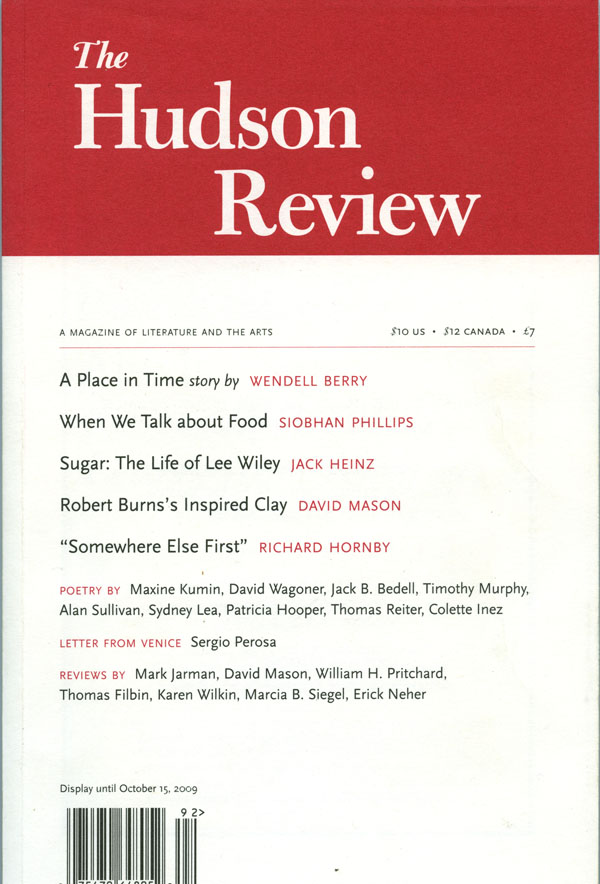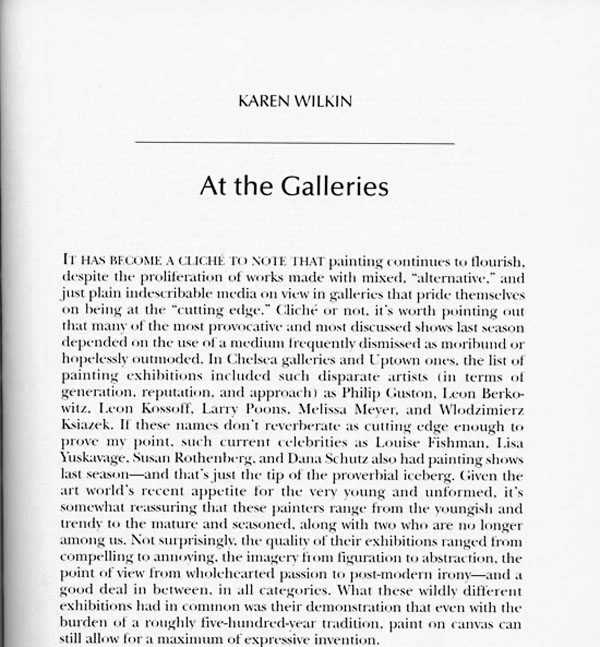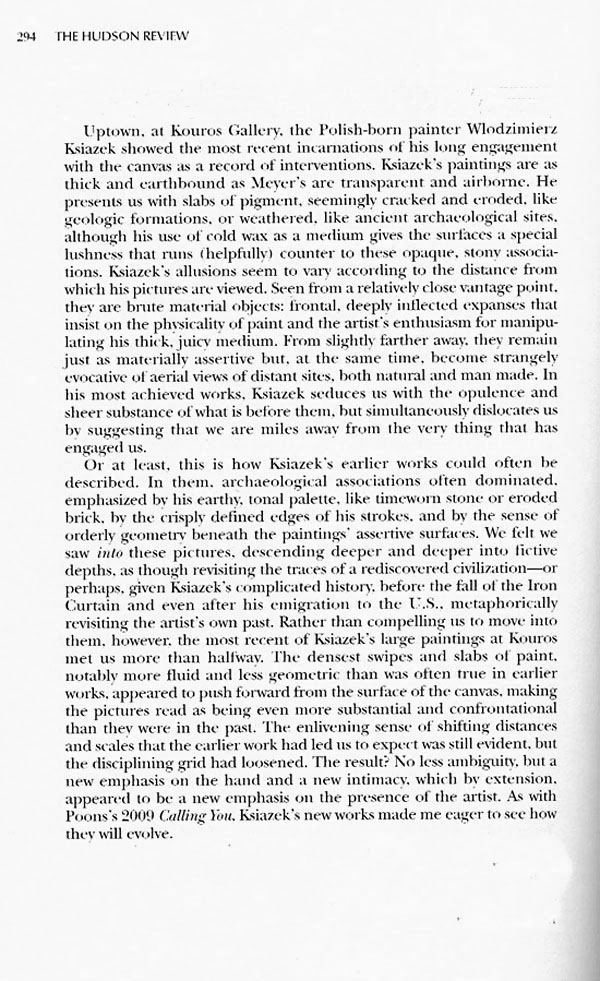"At the Galleries" by Karen Wilkin (edited)
The Hudson Review
IT HAS BECOME A CLICHÉ TO NOTE THAT painting continues
to flourish, despite the proliferation of works made with mixed, “alternative,” and
just plain indescribable media on view in galleries that pride
themselves on being at the “cutting edge.” Cliché or
not, it’s worth pointing out that many of the most provocative
and most discussed shows last season depended on the use of a medium
frequently dismissed as moribund or hopelessly outmoded. In Chelsea
galleries and Uptown ones, the list of painting exhibitions included
such disparate artists (in terms of generation, reputation, and
approach) as Philip Guston, Leon Berko-witz, Leon Kossoff, Larry
Poons, Melissa Meyer, and Wlodzimierz Ksiazek. If these names don’t
reverberate as cutting edge enough to prove my point, such current
celebrities as Louise Fishman, Lisa Yuskavage, Susan Rothenberg,
and Dana Schutz also had painting shows last season—and that’s
just the tip of the proverbial iceberg. Given the art world’s
recent appetite for the very young and unformed, it’s somewhat
reassuring that these painters range from the youngish and trendy
to the mature and seasoned, along with two who are no longer among
us. Not surprisingly, the quality of their exhibitions ranged from
compelling to annoying, the imagery from figuration to abstraction,
the
point of view from wholehearted passion to post-modern irony—and a good
deal in between, in all categories. What these wildly different exhibitions
had in common was their demonstration that even with the burden of a roughly
five-hundred-year tradition, paint on canvas can still allow for a maximum
of expressive invention.
Uptown, at Kouros Gallery, the Polish-born painter Wlodzimierz
Ksiazek showed the most recent incarnations of his long engagement
with the canvas as a record
of interventions. Ksiazek’s paintings are as thick and earthbound as
Meyer’s are transparent and airborne. He presents us with slabs of pigment,
seemingly cracked and eroded, like geologic formations, or weathered, like
ancient archaeological sites,
although his use of cold wax as a medium gives the surfaces a special lushness
that runs (helpfully) counter to these opaque, stony associations. Ksiazek’s
allusions seem to vary according to the distance from which his pictures are
viewed. Seen from a relatively close vantage point, they are brute material
objects: frontal, deeply inflected expanses that insist on the physicality
of paint and the artist’s enthusiasm for manipulating his thick, juicy
medium. From slightly farther away, they remain just as materially assertive
but, at the same time, become strangely evocative of aerial views of distant
sites, both natural and man made. In his most achieved works, Ksiazek seduces
us with the opulence and
sheer substance of what is before them, but simultaneously dislocates us by
suggesting that we are miles away from the very thing that has engaged us.
Or at least, this is how Ksiazek’s earlier works could
often be described. In them, archaeological associations often
dominated, emphasized by his earthy,
tonal palette, like timeworn stone or eroded
brick, by the crisply defined edges of his strokes, and by the sense of orderly
geometry beneath the paintings’ assertive surfaces. We felt we saw into
these pictures, descending deeper and deeper into fictive depths, as though
revisiting the traces of a rediscovered civilization—or perhaps, given
Ksiazek’s complicated history, before the fall of the Iron Curtain and
even after his emigration to the U.S., metaphorically revisiting the artist’s
own past. Rather than compelling us to move into them, however, the most recent
of Ksiazek’s large paintings at Kouros met us more than halfway. The
densest swipes and slabs of paint, notably more fluid and less geometric than
was often true in earlier works, appeared to push forward from the surface
of the canvas, making the pictures read as being even more substantial and
confrontational than they were in the past. The enlivening sense of shifting
distances
and scales that the earlier work had led us to expect was still evident, but
the disciplining grid had loosened. The result? No less ambiguity, but a new
emphasis on the hand and a new intimacy, which by extension, appeared to be
a new emphasis on the presence of the artist. As with Poons’s 2009 Calling
You, Ksiazek’s new works made me eager to see how they will evolve.
Karen Wilkin "At the Galleries", The Hudson Review,
2009



|